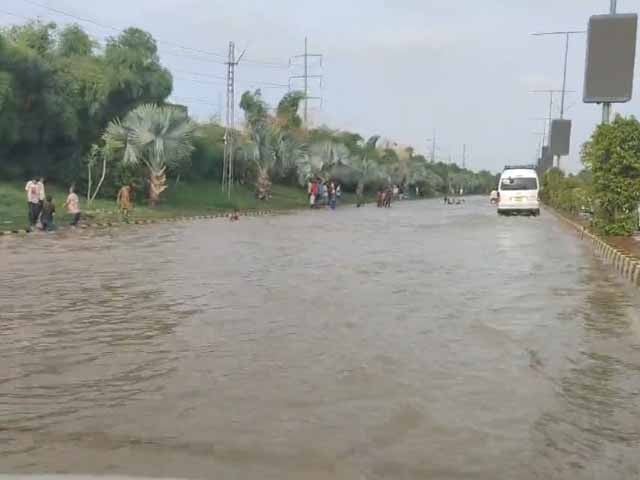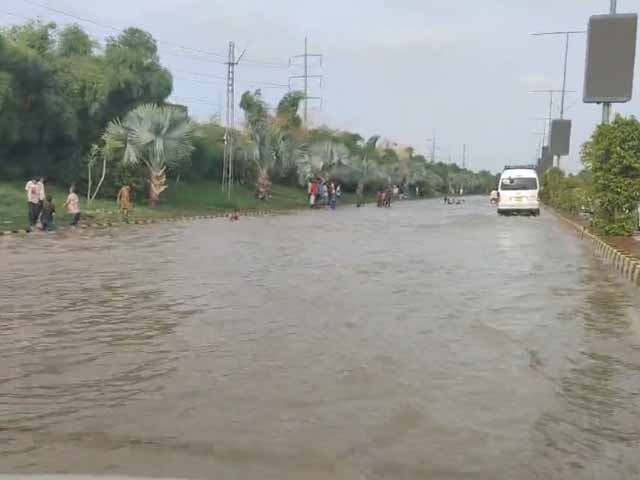
Photo: Screen grab
Lahore: Due to monsoon rains, several cities of Punjab, including Lahore, have lost many precious lives and properties due to urban flooding, while the claims of timely drainage arrangements by government agencies have been proved hollow this year as well.
According to experts, these problems are faced due to lack of cleaning of drains and storm drains due to which several feet of water accumulates in the low-lying areas of Lahore during rains. According to urban development experts, lack of complete cleaning of sewage drains and drains, encroachment on drains and drains and construction without any planning is a major cause of urban flooding.
The Provincial Disaster Management Authority (PDMA) had issued instructions to all concerned departments, including WASA, before the start of the pre-monsoon rainy season, that there is a risk of urban flooding due to more than normal rains this season, so all departments are on alert. stay
PDMA has warned of urban flooding in the low-lying areas of Lahore, Kasur, Okara, Kohat, Peshawar, Bannu, Kirk and DI Khan. Due to rains, standing water in low-lying areas of small and big cities is normal, due to the accumulation of several feet of water, the citizens also face problems on the streets and main highways.
To deal with this situation, the Punjab government devised a strategy to collect underground water and use it for plants and grass in parks. The Parks and Horticulture Authority (PHA) and WASA built the first underground rainwater harvesting tank at Bagh Jinnah, Lahore, which can store 1.4 million gallons of water, while 4 more such tanks are located in different areas of the city. But this project could not be completed.
According to WASA officials, all the drains and drains of the city were cleaned before the onset of monsoon rains, but the citizens say that this cleaning is nominal. A small part of a drain in Gulbarg area was cleared, the drain and the drain are still full of dung and silt causing very little water.
Arshad Khan, a citizen, said that the drain near his house was cleaned by WASA staff, took pictures and left.
Professor Noreen Fatimah, who researches town planning and development at a private university in Lahore, says that usually during heavy rains, when the water in the drains and sewers exceeds their capacity to handle, then After overflowing, this water starts collecting in the low lying areas along the roads. Public infrastructure is also affected by such situation.
Noreen Fatima says that the possibility of urban flooding increases due to overcrowding in cities, old drainage systems and lack of underground drainage of rainwater in cities. He said that there is a need to create a system of water recharging i.e. rainwater absorption into the ground, it not only reduces the risk of urban flooding but also increases the underground water level.
According to Professor Noreen Fatimah, more problems are faced in cities than in rural areas during heavy and more than normal rains because the roads in cities are paved, the courtyards of houses are also being paved, due to which water seeps into the ground. Absorption does not occur and flooding occurs.
An example of this was seen last month in the rains in Lahore on June 26 when several areas including the Kalma Chowk underpass were flooded, while the rains on July 5 created similar problems. It was the heaviest rainfall in the last 30 years.
On the other hand, WASA officials say that 5300 km long sewage lines are laid in Lahore for the drainage of sewage water. Along with such long sewer lines, seven large drains also flow for drainage. Citizens throw garbage into these drains and drains due to their openness, which makes their de-silting difficult.
WASA chief Ghafran Ahmed said that due to heavy and more than normal rain, water accumulated in many places, but all the low-lying areas were cleared within a few hours after the rain stopped. He said that the system is making drainage possible according to its full capacity, but there is room for improvement in every work.
(function(d, s, id){
var js, fjs = d.getElementsByTagName(s)[0];
if (d.getElementById(id)) {return;}
js = d.createElement(s); js.id = id;
js.src = “//connect.facebook.net/en_US/sdk.js#xfbml=1&version=v2.3&appId=770767426360150”;
fjs.parentNode.insertBefore(js, fjs);
}(document, ‘script’, ‘facebook-jssdk’));
(function(d, s, id) {
var js, fjs = d.getElementsByTagName(s)[0];
if (d.getElementById(id)) return;
js = d.createElement(s); js.id = id;
js.src = “//connect.facebook.net/en_GB/sdk.js#xfbml=1&version=v2.7”;
fjs.parentNode.insertBefore(js, fjs);
}(document, ‘script’, ‘facebook-jssdk’));



